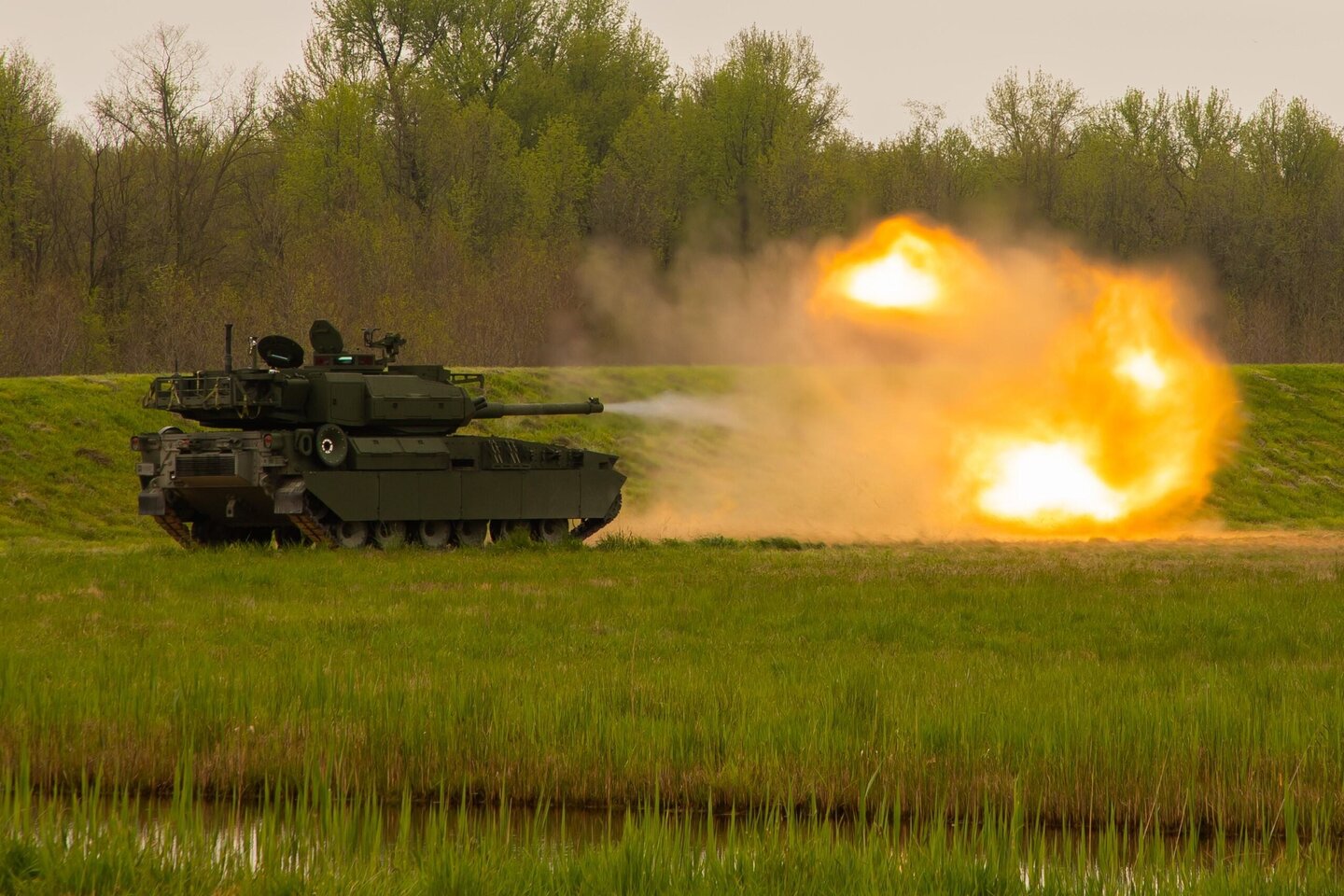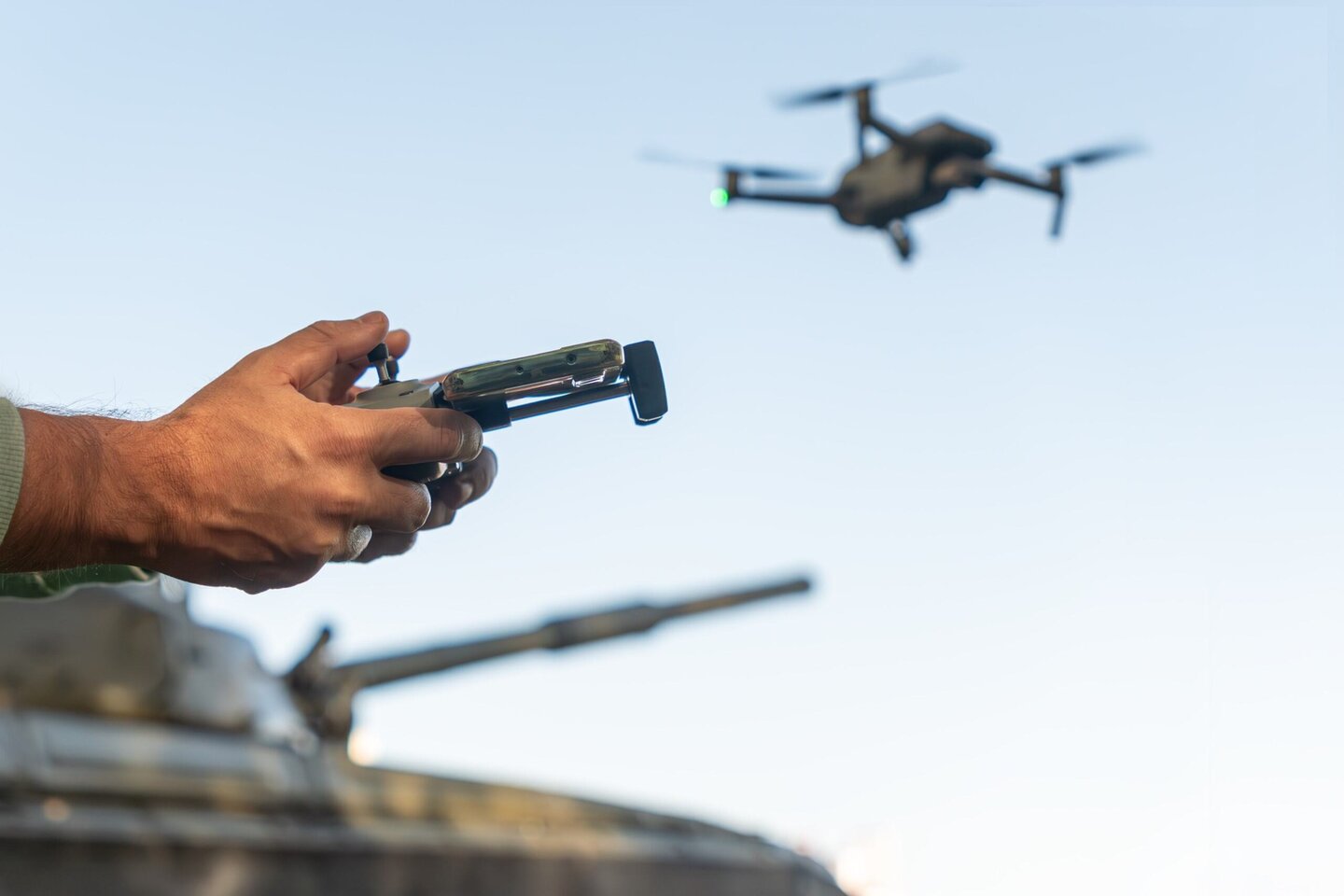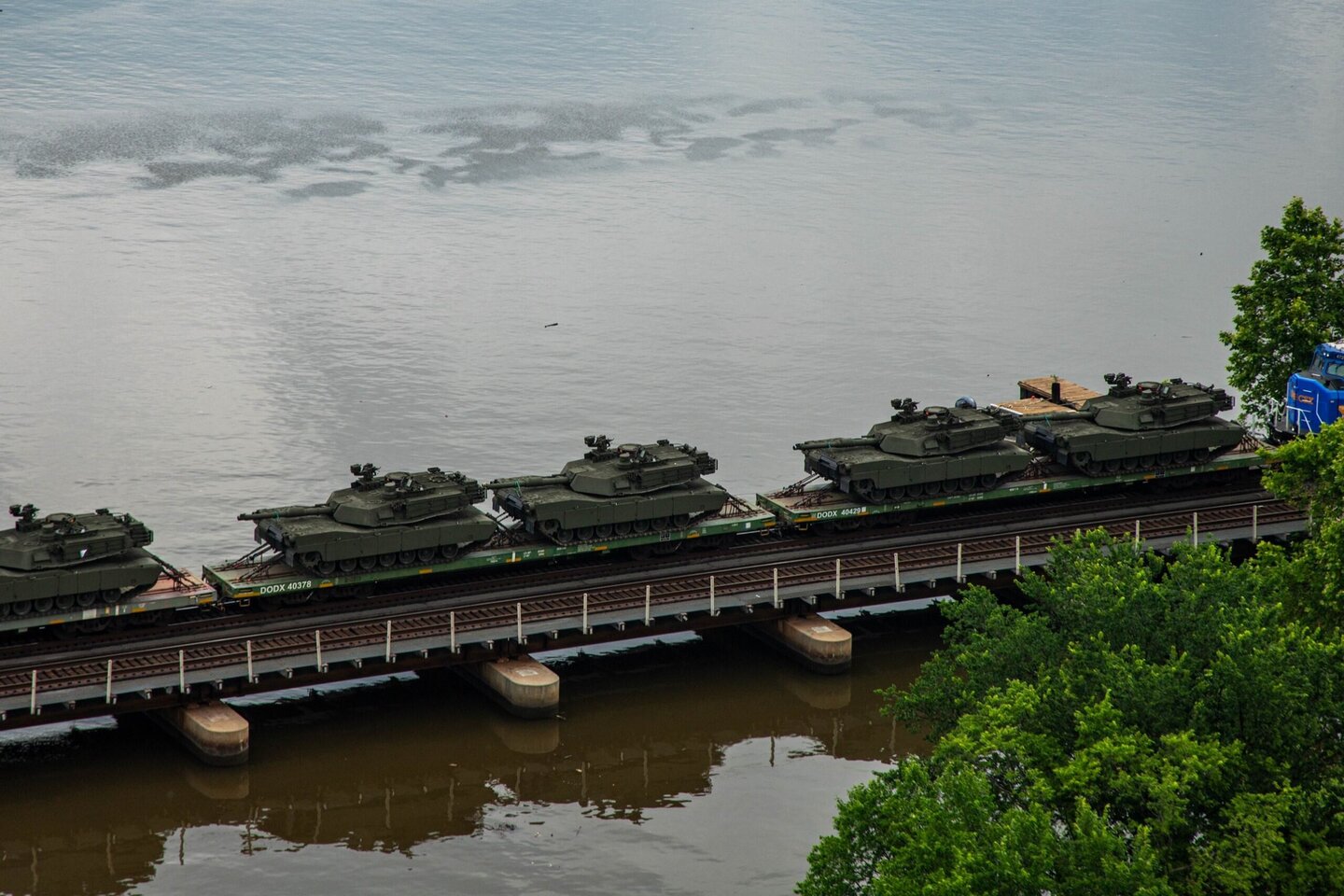Feature
The Booker dilemma: inside US Army transformation
The decision to cancel the M10 Booker light tank is at the core of a reordering of US Army planning. Jen Kirby reports.

A US Army M10 Booker light tank. Credit: U.S. Army / Cpl. Jonathon Downs
Officially, the M10 Booker is a ground combat vehicle. Unofficially, it’s a light tank. Whatever its designation, the United States Army created the M10 to provide mobile firepower to light infantry brigades.
The force sought armoured equipment that was easy to airdrop and could manoeuvre swiftly across terrains, while also being sturdy enough to withstand an enemy assault and possessing enough firepower to do some damage back.
But to meet all those requirements, the US Army got a bulkier vehicle than the more deployable, nimble one it initially envisioned. A tank – but not exactly a light one at around 40 tonnes. When the 101st Airborne Division received the first M10 Booker deliveries in 2024, it discovered eight of 11 bridges at Fort Campbell could not handle its weight.
This helps explain why the US Army abruptly cancelled the M10 Booker in May 2025. “The Booker is a classic example of sunk cost fallacy and the Army doing something wrong,” said Secretary of the Army Dan Driscoll.
The M10 Booker was not alone. In a 1 May memo, the US Army ended multiple programmes, including ground vehicles like the Joint Light Tactical Vehicle (JLTV) and the High Mobility Multipurpose Wheeled Vehicle (HMMWV, better known as the Humvee). It also axed “outdated crewed aircraft” such as the AH-64D helicopters and “obsolete” unmanned aerial systems like the Gray Eagle.
The Pentagon scrapped these platforms as part of its Army Transformation Initiative, the force’s effort to modernise and remake its capabilities and structure. The initiative stems from Secretary of Defence Pete Hegseth’s 30 April directive, which instructs the United States’s military to build a “leaner, more lethal” force that will prioritise defending the homeland and deterring China in the Indo-Pacific.
To do that, Hegseth wrote, the US Army must transform “at an accelerated pace by divesting outdated, redundant, and inefficient programs,” while increasing investments in long-range precision fire, missile defence, and counter-space capabilities.
“We will also continue to cancel programmes that deliver dated, late-to-need, overpriced, or difficult-to-maintain capabilities. Yesterday's weapons will not win tomorrow's wars,” wrote Dan Driscoll and the Chief of Staff of the Army Gen. Randy A. George in a letter about the initiative.
The US Army is betting that winning tomorrow’s war will require strategic capabilities, like integrated missile defence, but also high-tech kit that is cheaper to produce and more easily adaptable, especially compared to legacy platforms that take years to procure and field. In deciding which weapons to elevate, and which to abandon, the service is reshaping itself in real-time.
But that transformation comes with unanticipated tradeoffs, costs, and risks. Nothing is as simple as M10 Bookers out, autonomous drones in.
“The Army's in a really interesting place right now. I think they're grappling with these really, really fundamental questions about what the next war looks like,” said Tyler Hacker, a research fellow at the Center for Strategic and Budgetary Assessments.
As the US Army tries to determine that, Hacker added, it is also “asking, ‘well, if we do figure out what the next war looks like, what is the US Army's place in it?’”
M10 Booker is a window into a larger debate
The Army’s frame of reference for any future war is still today’s war – specifically the war in Ukraine. In the three years since Russia’s full-scale invasion, the battlefield has evolved week by week, and relatively inexpensive tools are taking out multi-billion-dollar strategic assets. Think Ukraine’s recent “Operation Spider Web” attack inside Russia, where US officials said Ukrainian drones costing as little as $600 destroyed Moscow’s $100m war planes.
“When you look at Ukraine and how the battle is being fought, it is no longer sufficient to have a long procurement process that takes two and a half years to get the first prototype, two more years to get it at scale, and then four years to get it in the hands of soldiers,” Secretary Driscoll said on a recent episode of the War on the Rocks podcast where he discussed the Army Transformation Initiative.
“Those eight years, contrasted with the two weeks right now that drones are being updated in Ukraine, have made it an imperative that either we do this now or we do it in the first six months of a conflict when American soldiers are losing their lives.”

Drones are revolutionising warfare. Credit: Melnikov Dmitriy / Shutterstock
The US Army sees something like the M10 Booker as a mismatch for this environment, which favors volume, flexibility, and even expendability. “The trick is you just got to buy quickly. You buy for what you need today. You make sure that the procurement isn't a once-in-a-lifetime procurement,” said Major General (Ret.) John G. Ferrari, a nonresident senior fellow at the American Enterprise Institute.
The M10 Booker underwent a years-long procurement process, with General Dynamics Land Systems (GLDS) winning the initial $1.4bn contract in 2022 for 96 M10s. Each cost about $13m for low-rate initial production – costly to make, and costly and time-consuming to repair or replace.
The M10 Booker contract also required the US Army to rely on General Dynamics to maintain the vehicle and its parts. Both Republican and Democratic officials have criticised these so-called “right to repair” clauses for ballooning defence costs and keeping vital equipment sidelined for months. The service is trying to reclaim its right-to-repair as part of its transformation initiative, assessing it as a faster, more cost-effective way to fix and adapt kit.
A spokesperson for General Dynamics said it would be premature to comment on the M10 Booker.
Similarly, the same goes with items like the JLTV, which is intended to replace Humvees, an armoured vehicle the Army has relied on for decades. George, the Army Chief of Staff, told War of the Rocks that the US Army already has 20,000 JLTVs and more than 100,000 Humvees. Given this, it was thought that the service did not need more, and instead see more promise with something like Infantry Squad Vehicles (ISVs), a light tactical vehicle based off a Chevrolet pickup truck that can move troops quickly.
George suggested the high maintenance involved in some of these older platforms, like the Humvee, decreased operational readiness and raised costs. Getting rid of them might solve both problems.
“Then we can spend the money on the things that we know we need, which is drones, loitering munitions, long-range fires, integrated air and missile defence, and all of our formations want counter-UAS capability. That’s what it’s really about: stop spending money on things we don’t need so that we can spend the money on the things that we know we do need,” explained George.
The US Army wants to transform. But into what?
Except no one is fully sure what the US Army needs because the next war is not here. The M10 Booker was not perfect, but it had the critical role of extending the range for infantry brigade combat teams. It is not clear what capability will replace it, and how the service will scale that up quickly. The same goes for items like the JLTV.
The Army declined to comment on the M10 Booker or Army Transformation Initiative because the information is “pre-decisional”.
Pat Donahoe, a former Deputy Commanding General of the 10th Mountain Division wrote on X that the decision to scratch M10 Booker spoke to an Army pursuing an “MBCT” concept – mobile brigade combat teams – without protected firepower, a recon platform, and a few light vehicles. “This isn’t transformation,” Donahoe wrote. “It’s disarmament.”
This is the tension at the center of the US Army’s transformation. The force wants to be more nimble, more resilient, and sees one solution in weapons that can be produced or updated quickly – and if they fail, they can be discarded before the Pentagon sinks millions or billions more into these programmes.
But there is no guarantee that this approach will deliver all the capabilities the Army needs. “There's this promise now of these small, cheap, numerous, systems – small drones and other things, cheap weapons that are going to supposedly replace all these legacy systems and make them obsolete,” Hacker said. But despite the temptation to go all-in, it is not clear that all of these technologies “are fully mature enough to replace the legacy systems in a lot of scenarios.”
The fear is that the US Army is chasing shiny new objects for a future war, while ignoring the ways war does not change. Cheap quadcopter drones and electronic jammers altered the Ukrainian battlefield, but it did not make obsolete mines or artillery.
A reliable first-strike capability that results in near-elimination of a devastating retaliatory capability is not feasible
Dr Tom Stefanick, non-resident senior fellow, Brookings Institution
“A reliable and rapid first-strike capability with thermonuclear weapons is unlikely to result in the complete elimination of an opponent’s nuclear arsenal [at present],” he determined. “I think a reliable first-strike capability that results in near-elimination of a devastating retaliatory capability is not feasible”.
Meanwhile, Manning forecasts that AI-enhanced missile targeting is still estimated to be about four years away, meaning until then offensive missile systems are unlikely to be any more accurate in a first strike attack scenario than they are at present.
Instead, AI is more likely to have an impact in the management of how countries deploy the variety of weapons that they now have access to, to overwhelm and confuse their enemies’ defences, deterring them from believing they could protect themselves in the event they attacked first. Countermeasures to sensing in the physical battlespace from the seabed to outer space are very active areas of research, said Stefanick.
A bigger issue around AI and missiles, according to Manning, is the geopolitical uncertainty created from the fact that Russia and China cross nuclear weapons safety and security boundaries that the US sets for itself and its allies.

Heavy armour is still needed to secure ground, some argue. Credit: U.S. Army / Spc. Rebeca Soria
“When you sell off your soul to buy all these drones, you're selling off your land force to fund that,” said Amos Fox, professor of practice at Arizona State University's Future Security Initiative. As Fox said, there are continuities in war, and they revolve around territory – taking it, holding it, and then sealing borders.
Drones can help, but they cannot keep territory. “This is the rub, I think, when we are looking at, ‘oh man, drones, the future of war, let's kill off all the tanks, the Booker being one of those. Well, that's probably actually the last thing you want to do,” Fox said.
Of course, it is not just drones, and the US Army is not scrapping all of its legacy systems, though it will likely pick-and-choose which to upgrade with artificial intelligence or advanced communication networks. Because the Pentagon – even with the Trump administration’s proposed $1trn defence budget – has finite resources and will make tradeoffs.
But the US Army has not fully laid out why these tradeoffs are the right ones and is yet to outline a transition plan from the force that exists now to the one it seeks to build. There is not yet a coherent strategy on how the US Army plans to use – and fight with — the capabilities it says it wants. “That seems to me to be the missing link right now,” said Andrew F. Krepinevich Jr., a senior fellow at the Hudson Institute.
“We've gone basically from ‘focus much more on China,’ and ‘we're going to cut this equipment and maybe buy new equipment,’” he added. “But we haven't really said how we see the Army being deployed.”
We are always looking for opportunities that innovative technologies potentially offer to improve our training delivery
Commodore Steve Jose, UK MFTS head
Caption. Credit:

Phillip Day. Credit: Scotgold Resources
Total annual production
Australia could be one of the main beneficiaries of this dramatic increase in demand, where private companies and local governments alike are eager to expand the country’s nascent rare earths production. In 2021, Australia produced the fourth-most rare earths in the world. It’s total annual production of 19,958 tonnes remains significantly less than the mammoth 152,407 tonnes produced by China, but a dramatic improvement over the 1,995 tonnes produced domestically in 2011.
The dominance of China in the rare earths space has also encouraged other countries, notably the US, to look further afield for rare earth deposits to diversify their supply of the increasingly vital minerals. With the US eager to ringfence rare earth production within its allies as part of the Inflation Reduction Act, including potentially allowing the Department of Defense to invest in Australian rare earths, there could be an unexpected windfall for Australian rare earths producers.
